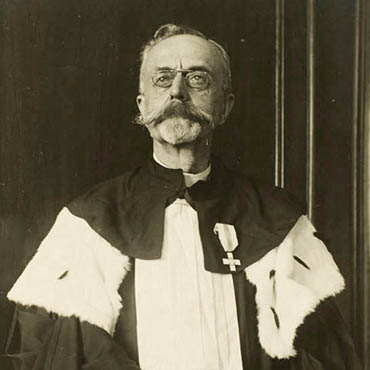Antonio Favaro was born in Padua in 1847: his father was a mathematician and his mother was a descendant of a family from Polesine with a patriotic past. After high school, where he had as a teacher Giacomo Zanella, he studied mathematics at the University of Padua, where he attended the lectures of Giusto Bellavitis, Serafino Rafaele Minich, Gustavo Bucchia, Giovanni Santini and Domenico Turazza, and graduated in 1866. He then moved to the School of Applied Military Science in Turin and graduated in engineering in 1869. After attending the Zürich Polytechnic for a few months, he was invited to work at the University of Padua as assistant to Domenico Turazza (his future father-in-law), but had to replace him as a teacher of rational mechanics almost immediately, during Turanzza’s long period of absence. After moving rapidly through the early stages of his career, in 1872 he became a temporary professor of graphical statics, which he taught for decades to come, becoming a full professor only in 1882. When Minich retired, he took his place as a lecturer on sublime calculus and for almost thirty years he also taught projective geometry.
For the whole length of his career as lecturer, and up to the time that the post was cancelled in 1911, he held courses on the history of mathematics. His idea was that knowing the history was fundamental for learning and understanding a number of disciplines, because they should be viewed in their historical development. Apart from some early works on engineering, seismology and education, history of science was at the centre of his substantial production over the whole of his life, from the time of his acquaintance with Baldassarre Boncompagni, to whose “Bullettino di bibliografia e di storia delle scienze matematiche e fisiche” he made frequent contributions during the twenty years’ life of the journal.
The necessity to turn, in the process of historical reconstruction, to texts and documents analysed with the same rigour as scientific data was a revolutionary idea at the time, compared to the arbitrary nature of preconceived and ideological visions, and led to his unearthing unexplored collections and archives. Starting from the history of mathematics in the University of Padua, he moved to Galileo, who in a short time became the focus of his studies and the main interest of his life. His work Galileo Galilei e lo Studio di Padova, published in 1883, opened the floodgates of that immense mass of articles, pamphlets and books dealing with even the smallest details of the life and works of Galileo, with his friends and correspondents, opponents and adversaries, which would become the germ and the foundation of that daring undertaking that was the national edition of the works of Galileo.
Launched in 1887 with a decree by the Education Minister Michele Coppino, the monumental, and, for the first time, meticulous edition of Galileo appeared in twenty volumes between 1890 and 1909. This publication was the result of contributions from numerous consultants and advisers and thanks to the collaboration of Umberto Marchesini and, above all, Isidoro Del Lungo; it took account of even the smallest document and it was successful, despite the thousand obstacles that showed up the abrupt historical and cultural changes of the fragile new nation.
At the same time Favaro continued his research on the history of the University of Padua and, after the middle of the 1880s, he included Leonardo da Vinci in his studies. Once the edition of Galileo was completed, Leonardo became the focus of his interest. This resulted in his becoming a member of the Commissione vinciana, which was expected to plan the national edition of the works of Leonardo.
He was a member of many academies but was particularly interested in the work of the Istituto veneto di scienze, lettere ed arti, of which he was president from 1905 to 1906: in fact, it was the “Atti” of this Institute that he chose for the publication of a significant part of his articles on Galileo. From the 1870s he had got to know Raffaello Caverni; he became his friend and proposed that Caverni should collaborate on the national edition of Galileo in the production of a commentary and the edition of the writings De motu. He also did all he could to ensure that the Storia del metodo sperimentale in Italia won the Tomasoni prize offered by the Istituto veneto.
Relations between the two of them became strained when Caverni was made aware that the prize would be released only after the work was printed, and broke down completely when it was decided that the national edition would not be accompanied by any commentary. Given that Gilberto Govi was not kindly disposed towards Caverni, Favaro made only half-hearted attempts to oppose his voluntary and progressive withdrawal from the work on De motu. He learnt late of the publication of the first volumes of the Storia del metodo sperimentale in Italia and decided not to reply to the attacks unleashed on his edition, as well as on “his” Galileo; from then on he referred to Caverni as ”the honest prior”. Only many years later he cruelly placed him among the Adversaria Galilaeiana, including him, without even mentioning his name, under the heading Scritture galileiane apocrife. Antonio Favaro died suddenly at Padua in 1922.

